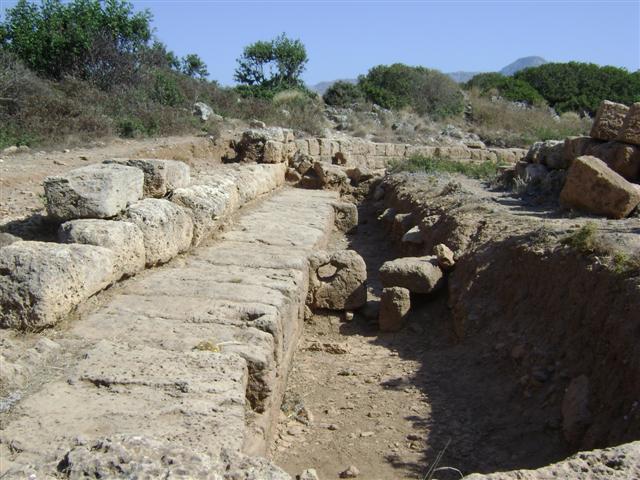About Falassarna

Ancient Falassarna
A 2400 years of history
About Falassarna
Welcome to Falassarna area
During your stay in the area don't miss to visit Falassarna ancient city ruins.
The old port is located out of the water after the big earth quake which leveled the area 10meters over the ground. On the east side, on the mountain the ancient temple of Dimitra is discoverd 2021.
History - Old Falassarna Hurbor
The site of ancient Phalasarna (Falassarna) is situated on the western edge of Cape Grambousa on the west coast of Crete in the county of Chania. Named Korykos in antiquity the area includes a rocky promontory from which the view of the sea to the west of Crete is impressive, and upon which the acropolis of Phalasarna (Falassarna) was built. The cape that encloses the area, called Koutri, may be divided into five segments; firstly, the acropolis mentioned previously which protects the bay from the seaward side. A second area is the small valley that opens to the south east of the acropolis with access to the sea to the south. The slopes that enclose this valley rise to the south and east where the boundaries of the settlement began and where the necropolis was situated. The fourth and fifth areas comprise the two bays, one to the south that allowed entrance to the harbor, and another to the north which is rocky and less hospitable.
The area was occupied from the Middle Minoan period as sherds on the surrounding slopes and in the harbour silt indicate, and graves of the 6th BC attest to an Archaic settlement, however it was from the second half of the 4th BC until the mid-first century BC that Phalasarna flourished. During this period the settlement boasted a enclosed harbour around which strong fortifications were constructed, including several towers. Entrance to this complex arrangement could be gained through the specially excavated channel that connected the harbor with the sea. Located south of the main fortification walls, the enclosed harbor measured approximately 100m x 75m and was surrounded by walls and fortified towers. The fortification walls, apart from enclosing the city, also extended around the harbor to the west where four square towers are reported. There is also evidence that to the southeast a second wall enclosed the lower area to the south of the settlement. There is evidence of several constructions on the acropolis, located to the north of the enclosed harbor, which are in a poor condition, however it is suggested that two of these may have functioned as temples. Also located on the acropolis are several cisterns and wells. Both the cemeteries discovered in the area are located to the southeast of the fortification walls, the smaller of which belongs to the 6th century BC. The larger cemetery has been dated to the late 4th century BC, and extends for approximately 500m from the fortification wall. Finally, to the south of the harbor a rock cut ‘throne’ has been discovered, and below it may be seen, amongst other features, the quarry that was used to supply the building material for the settlement.
The site of Phalasarna (Falassarna) was utilized from the Middle Minoan period through to the mid-1st century BC. The earliest phases are still unknown, however from the 4th century BC the settlement flourished and could boast of strong fortifications and a closed harbour, a naval force to be reckoned with, a mint, several temples, and the trappings of a prosperous city with access to trade routes. The city reached its pinnacle in the glow of the Hellenistic world situated as it was on the route between Ptolemaic Alexandria and the Aegean. The sources of the city’s wealth may well have derived from piratical ventures as was common in the Mediterranean, however this conflicted with the interests of the expanding Roman political, social, and economic network. In an attempt to eliminate the pirate nests dotted around the coast of Crete Roman military forces eventually destroyed the city in 69 BC. The settlement never recovered from this action, although a Roman town located further south adopted the name of Phalasarna. Other factors such as a rise in sea level may also have contributed to the city’s decline. Massive earthquakes in 365 AD eventually raised the area 6.66m.
